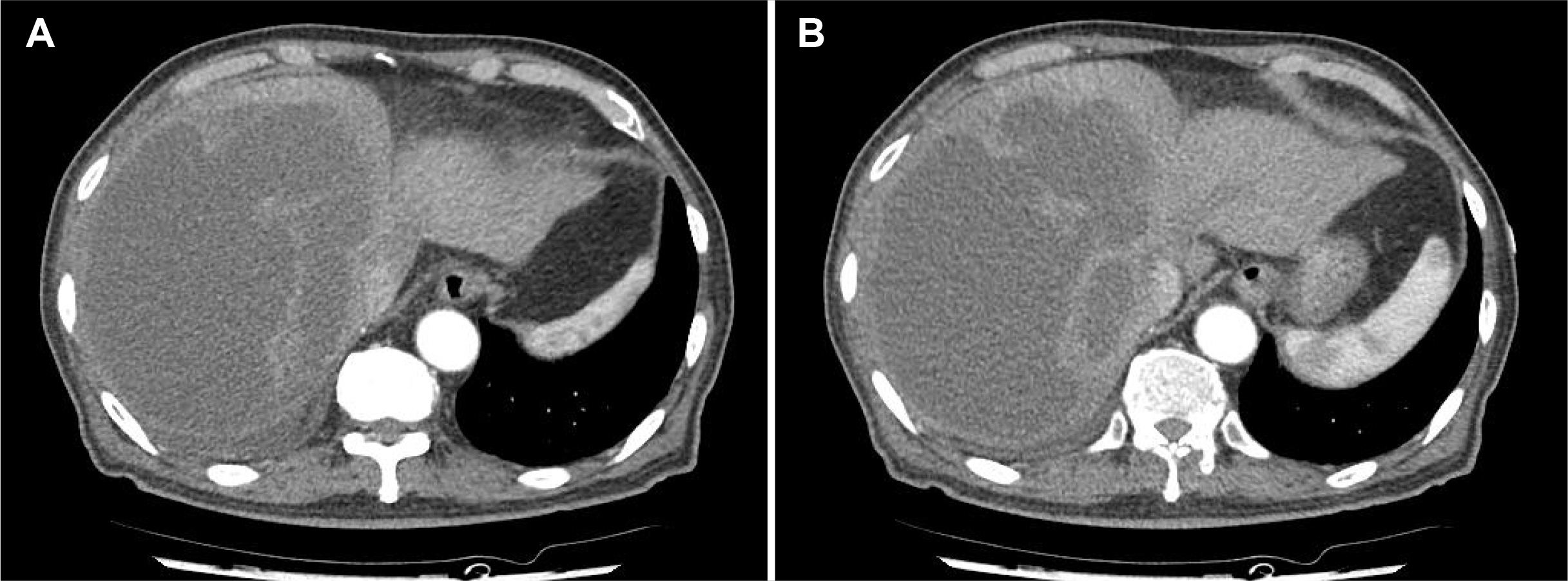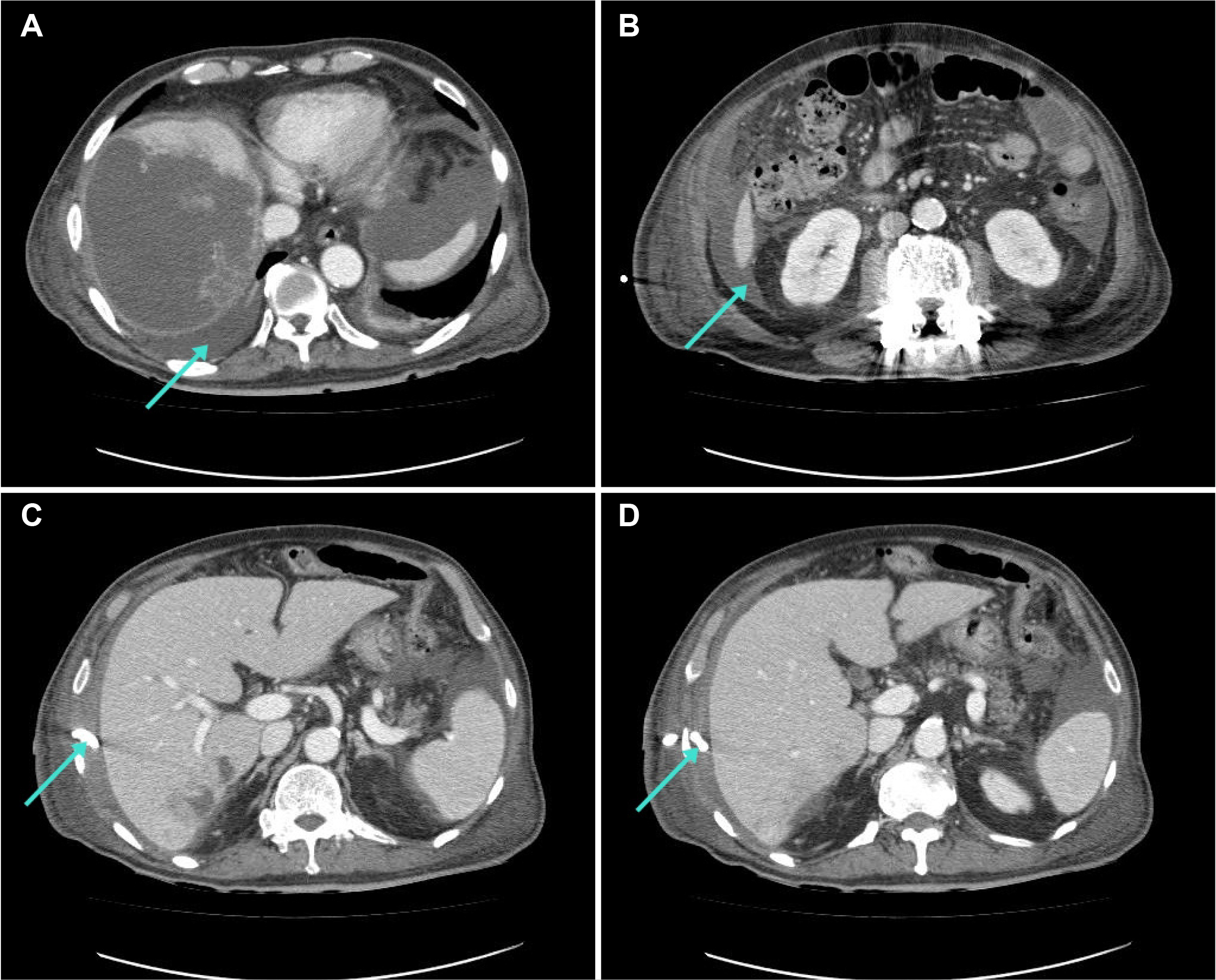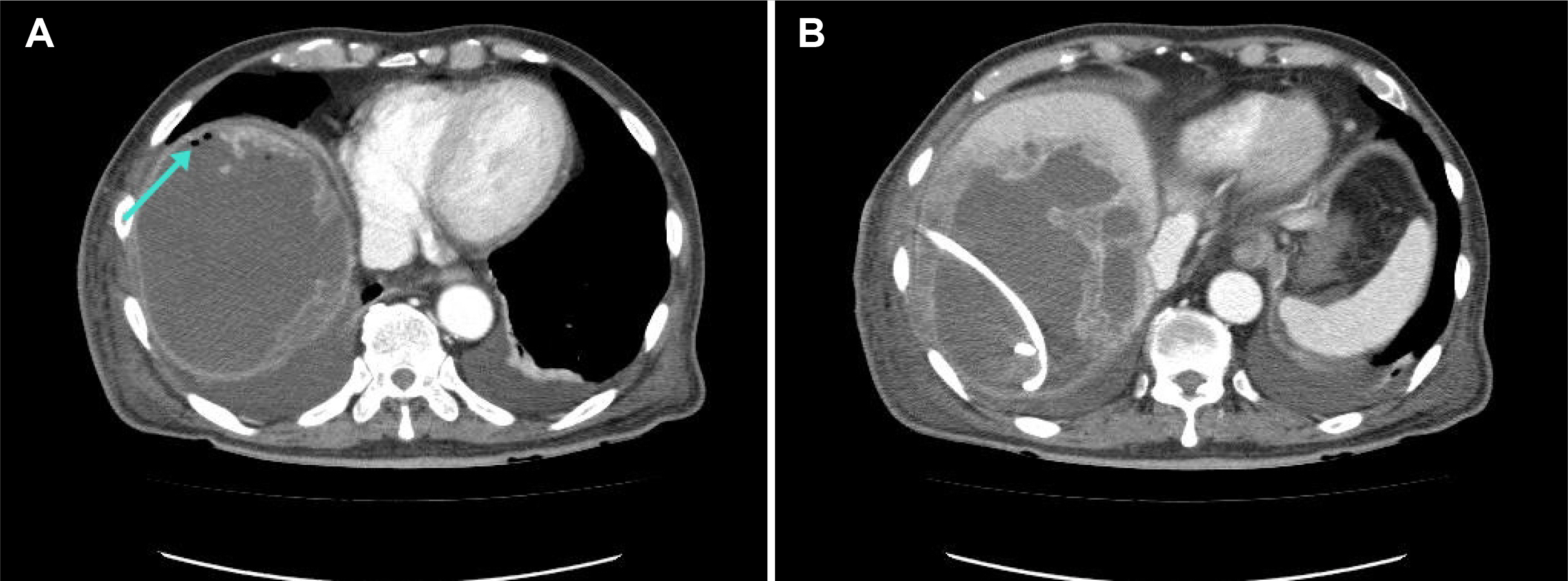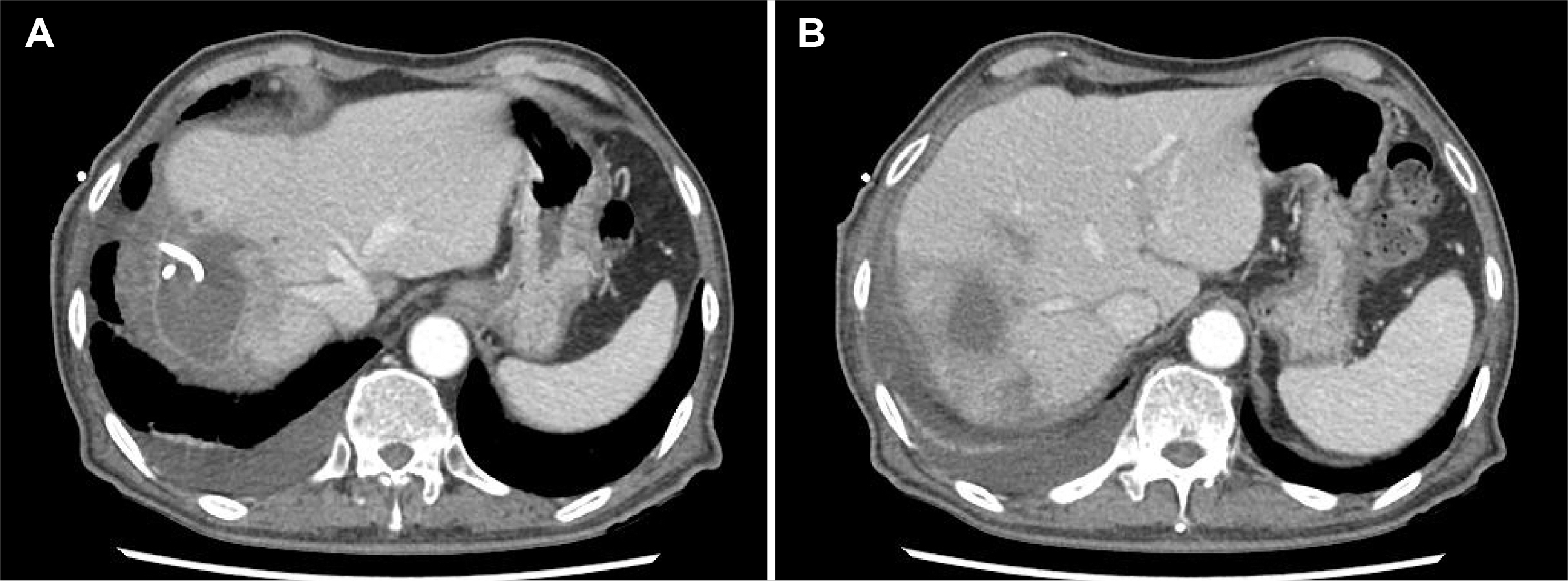Korean J Gastroenterol.
2021 Apr;77(4):190-193. 10.4166/kjg.2021.005.
Successful Medical Treatment for Peritonitis Resulting from a Large Pyogenic Liver Abscess Rupture
- Affiliations
-
- 1Department of Internal Medicine, Seoul Paik Hospital, Inje University College of Medicine, Seoul, Korea
- KMID: 2515140
- DOI: http://doi.org/10.4166/kjg.2021.005
Abstract
- The rupture of a pyogenic liver abscess (PLA) with peritonitis is a rare occurrence but a surgical emergency with a high mortality rate in the case of gas-forming PLA. Rare cases of ruptured PLA that recovered completely with only medical treatment have been reported. This paper reports a case of a large PLA rupture with peritonitis. In this case, surgical intervention was too risky because of the patient’s age and poor general condition. The patient recovered fully with appropriate antibiotic therapy and sufficient percutaneous drainage. Therefore, medical treatment may be considered an alternative option in cases of a ruptured large PLA with peritonitis if surgical intervention is too risky.
Keyword
Figure
Reference
-
1. Elia C, Bracco C, et al. erraino C. 2018; Characteristics and management of pyogenic liver abscess: a european experience. Medicine (Baltimore). 97:e0628. DOI: 10.1097/MD.0000000000010628. PMID: 29742700. PMCID: PMC5959441.2. Abbas MT, Khan FY, Muhsin SA, Al-Dehwe B, Abukamar M, Elzouki AN. 2014; Epidemiology, clinical features and outcome of river abscess: a single reference center experience in Qatar. Oman Med J. 29:260–263. DOI: 10.5001/omj.2014.69. PMID: 25170406. PMCID: PMC4137581.3. Sohn SH, Kim KH, Park JH, Kim TN. 2016; Predictors of mortality in Korean patients with pyogenic liver abscess: a single center, retrospective study. Korean J Gastroenterol. 67:238–244. DOI: 10.4166/kjg.2016.67.5.238. PMID: 27206434.
Article4. Chou FF, Sheen-Chen SM, Lee TY. 1995; Rupture of pyogenic liver abscess. Am J Gastroenterol. 90:767–770.5. Thng CB, Tan YP, Shelat VG. 2018; Gas-forming pyogenic liver abscess: a world review. Ann Hepatobiliary Pancreat Surg. 22:11–18. DOI: 10.14701/ahbps.2018.22.1.11. PMID: 29536051. PMCID: PMC5845606.
Article6. Jun CH, Yoon JH, Wi JW, et al. 2015; Risk factors and clinical outcomes for spontaneous rupture of pyogenic liver abscess. J Dig Dis. 16:31–36. DOI: 10.1111/1751-2980.12209. PMID: 25385432.
Article7. Motoyama T, Ogasawara S, Chiba T, et al. 2013; Successful non-surgical treatment of ruptured pyogenic liver abscess. Intern Med. 52:2619–2622. DOI: 10.2169/internalmedicine.52.0980. PMID: 24292751.
Article8. Lee KJ, Ryu SH. 2018; Ruptured gas-forming pyogenic liver abscess into the peritoneal cavity treated successfully with medical treatment. Korean J Gastroenterol. 71:45–48. DOI: 10.4166/kjg.2018.71.1.45. PMID: 29361813.
Article9. Kong H, Yu F, Zhang W, Li X. 2017; Clinical and microbiological characteristics of pyogenic liver abscess in a tertiary hospital in East China. Medicine (Baltimore). 96:e8050. DOI: 10.1097/MD.0000000000008050. PMID: 28906397. PMCID: PMC5604666.
Article10. Chung DR, Lee SS, Lee HR, et al. 2007; Emerging invasive liver abscess caused by K1 serotype Klebsiella pneumoniae in Korea. J Infect. 54:578–583. DOI: 10.1016/j.jinf.2006.11.008. PMID: 17175028.
Article11. Liu Y, Wang JY, Jiang W. 2013; An increasing prominent disease of Klebsiella pneumoniae liver abscess: etiology, diagnosis, and treatment. Gastroenterol Res Pract. 2013:258514. DOI: 10.1155/2013/258514. PMID: 24194749. PMCID: PMC3806164.12. Lübbert C, Wiegand J, Karlas T. 2014; Therapy of liver abscesses. Viszeralmedizin. 30:334–341. DOI: 10.1159/000366579. PMID: 26287275. PMCID: PMC4513824.
Article13. Desai N, Parmar N, Negi S. Savani. C Soni D. 2015; Management of ruptured liver abscess: a study of 54 cases. IJSR. 4:1651–1654.14. Önder A, Kapan M, BöyüK A, et al. 2011; Surgical management of pyogenic liver abscess. Eur Rev Med Pharmacol Sci. 15:1182–1186.15. Chong VH, Zainal-Abidin Z, Hassan H, Chong CF. 2010; Rare complications of pyogenic liver abscess. Singapore Med J. 51:e169–e172.16. Zizzo M, Zaghi C, Manenti A, Luppi D, Ugoletti L, Bonilauri S. 2016; Abdominal wall abscess secondary to spontaneous rupture of pyogenic liver abscess. Int J Surg Case Rep. 25:110–113. DOI: 10.1016/j.ijscr.2016.06.026. PMID: 27351622. PMCID: PMC4925907.
Article17. Chung YF, Tan YM, Lui HF, et al. 2007; Management of pyogenic liver abscesses - percutaneous or open drainage? Singapore Med J. 48:1158–1165.
- Full Text Links
- Actions
-
Cited
- CITED
-
- Close
- Share
- Similar articles
-
- Ruptured Gas-forming Pyogenic Liver Abscess into the Peritoneal Cavity Treated Successfully with Medical Treatment
- Treatment of Liver Abscess
- A Case of Large Bile Duct Stones Complicated by Pyogenic Pericarditis, Liver Abscess, and Pyothorax
- Spontaneous Pneumoperitoneum Secondary to the Rupture of a Gas-Containing Pyogenic Liver Abscess
- Pyopneumoperitoneum by Spontaneous Rupture of Pyogenic Liver Abscess





